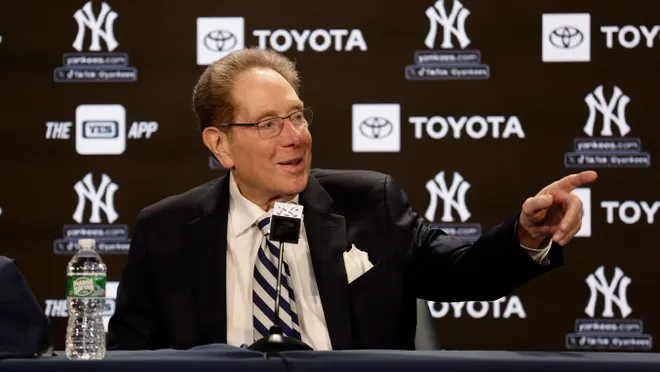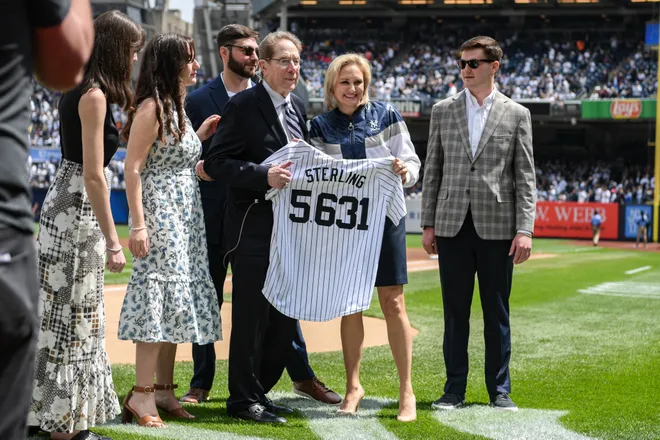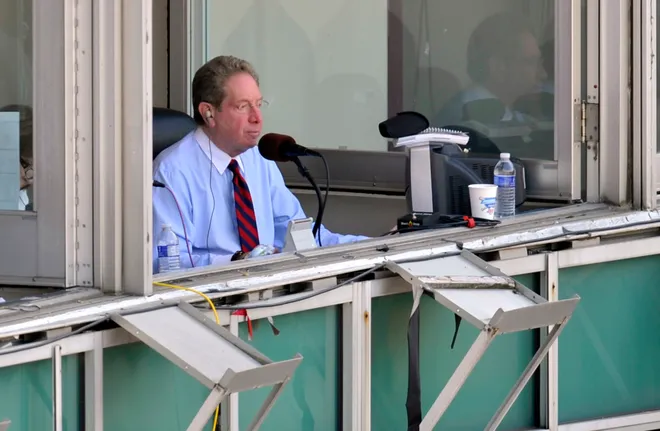Retired Yankees announcer John Sterling was so much more than a friendly voice on the radio
New York Yankees fans have woken up to the reality of a second weekend without their warm, familiar voice.
For 36 years, John Sterling was a constant presence, dancing (and sometimes blasting) through their ears, whether it be in the car, through headphones, or just flowing out into their living rooms.
He took us along for one of the great rides in Yankees history, wherever we were. I used to tune into him on North Carolina nights in the late 1990s, where the powerful Yankees radio network could be picked up hundreds of miles away.
I was working in my first job out of college, starting out in a profession, and I sometimes felt Sterling was right there with me. That was so much in itself. I had no idea he would someday mean even more to my career.
Sterling stepped away last weekend as, in his partner Suzyn Waldman’s words, “the voice of the Yankees.” He retires with many friends in the game. I don’t claim to be one of them, but I will always remember how he supported me.
MLB SALARIES: Baseball's top 25 highest-paid players in 2024
Mentors can work that way, even if their interactions with you are sporadic or brief. If you are an athlete, especially a young athlete, you know the feeling you get from a senior influence in your life. It might be the older kid down the block who takes time to offer pointers at your driveway hoop. Or, when you’re older, it’s the towering player on varsity who stops to introduce himself or herself after you’ve made JV.
Those moments stay with us in life, like Sterling did on all those summer nights.
Thanks to my profession, I eventually got meet to John, shaking his hand on the field at Yankee Stadium in 2001. It was there that Sterling, in surprisingly self-effacing fashion, told me the origins of his most famous phrases on the air.
"For 1,000 years, when two guys hit home runs, they say, 'Back-to-back,'" he said. “Harry Belafonte has a calypso song — years ago — and he's singing, 'And they go back-to-back and belly-to-belly.' ”
Those seven words - back-to-back and belly-to-belly - happily, and sometimes musically, came out of Sterling when the Yankees hit consecutive home runs.

“So odd, so dumb,” he said then. “It doesn't even mean anything."
It meant more than he knew. I got a deeper look inside him when I was researching a biography on his most famous predecessor in the Yankees booth, Mel Allen, a few years later.
“Mel represented for me the best of New York,” he would tell me. “You know, Madison and Fifth Avenue, networks, CBS at 485 Madison. I was really drawn into that.
“He was my hero.”
As it turns out, he became Sterling’s mentor, too. Through both of their stories, I learned how we can always pay it forward, no matter how successful we get.
Sterling’s father sold menswear advertising in New York when John was a wide-eyed boy following baseball. Allen, who started out as a young CBS staff announcer, knew his father from a showing.
“How could you possibly know that,” Sterling told me when I mentioned to him that Allen had met his father.
I had found out where Sterling and Yankees were staying on a road trip in May 2004 and called the hotel. I asked the front desk for him and they put me through. He answered after a couple of rings.
He didn’t remember me, but he immediately took an interest in my project, I think, because I was prepared with the link between him and his father.
Sterling invited me to Yankee Stadium to continue our discussion before a game. Our conversation, and his friendly guidance over a young writer’s career, was just beginning.
COACH STEVE:What young athletes can learn from the legendary John Wooden
He put me on the air: John Sterling, like Mel Allen and George Steinbrenner, cared about 'the little guy'
Baseball broadcasters are your friend, even if you don’t know them. The natural pauses in the game, especially before the pitch clock came about last season, allow for that friendship to grow through the narrator’s stories and personal touches.

Allen could sell beer (Ballantine beer) like no announcer could during those pauses. Sterling remembers watching him, around the onset of TV, pull one out of a little cooler and pour it for his viewers.
“He would sit there and say, ‘We have to wait till after the game, but you can have yours right now,’” Sterling said when I met him at Yankee Stadium again a few days after our phone call. “And he would take a beautiful beer glass and it would be some July, August night, you see this big, heavy, sweaty man, and he’d pour it...it’d hit the top side and it would come out perfectly.
“Now do you think that sold beer?! Wow!”
When I reminded Sterling how he had dedicated his broadcast to Mel on the day Allen died in 1996, he grew silent in thought. He was choked up. He had lost a friend that day. And it wasn’t the first time.
Sterling was in his 20s when Allen, the soundtrack of a previous Yankees dynasty, virtually disappeared from the airwaves. The Yankees decided in 1964 to pull the plug on him after 25 years doing their games, looking for a fresh voice and new image. Dismissing a broadcaster is common in the business, but this one resounded all over New York because Allen was bigger than life to so many.
Unlike with Sterling, the Yankees regime at the time never gave Allen a proper forum to say goodbye to his fans on his own terms. It was a cruel way to handle someone who had spread the team’s popularity to so many fans, including Sterling.
“It’s so tough for me to relate exactly what I feel,” Sterling told me about Allen, “because I’m not able to put (it) into words. There I am, a guy a with a big mouth. I loved every game he did. I thought it was an event.”
You can imagine how he felt when he met Allen in the late 1970s. Sterling was around 40 and still hadn’t become the Yankees play-by-man. He was doing a talk show on New York station WMCA, which looked to capitalize on the Yankees’ re-emergence under a young, enterprising owner named George Steinbrenner.
Sterling found himself on Yankees pre- and postgame shows with Allen, whom Steinbrenner had welcomed back into the Yankees family. They became good friends, taking a shared interest in each other’s pursuits. It’s kind of the way I felt talking to Sterling, eating with him in the Yankee Stadium press dining room and listening to his stories about interviewing celebrities in Steinbrenner’s office after a clinching World Series victory.
Sterling, of course, was working next to one of his favorite celebrities of all.
“Whoever you’d think is great, including Cary Grant and (Walter) Cronkite, whoever you think is big, we had on,” Sterling said. “And Mel, to his dying day, when he’d see me, he’d say, ‘Can’t we get tape of that? That was the best show I ever did. John. We should get a tape.'"
Sterling loved how Allen would kid him about his Grant impression and, more deeply, felt Mel’s support when Steinbrenner hired him to be the Yankees’ play-by-play guy in 1989. Think of the best player in your school’s history coming back to hand the ball off to you.
Allen knew about the importance of giving back when we get opportunities in our careers like he had. In the 1950s, he had taken a blind phone call from an assistant football coach at Northwestern who was exploring a career in sportscasting.
“He didn’t know me from Eve,” Steinbrenner told me in an interview for my book, which was published in 2005. “He cared about the little guy. I tried to never forget it.”
Sterling laughed, along with Waldman, when I recalled the story for them of how Mel spent 45 minutes talking to young George on the phone. We were on the air.
"Strike on the inside corner," Sterling said, still chuckling. "And you know very well because you've done so much research: Mel could speak for an hour."
I was an unknown, like Steinbrenner had been, standing behind them during a Yankees-Pirates game and holding a microphone. Waldman turned to me and smiled.
“We're talking with Stephen Borelli, who's written a terrific book,” Sterling told listeners. “Now we can both recommend the book because we both read the book. And it touches on many sensitive issues as well … it’s a heck of a story."
He repeated a version of that line three times the during interview, which he expertly weaved in between pitches like Mel had done on those beer ads.

Like with our previous meeting, Sterling had casually told me to let him know when I could come to Yankee Stadium, where he would put me on the air for a half inning to promote the book. In this inning, though, the Yankees quickly recorded two outs.
“Well, this is a great interview, Stephen,” he said in his conversational style. “Two pitches, two outs. So I think we'll have to keep you to the bottom of the third, give you a break.”
He and Waldman gave me more than that. It was my 10 minutes of fame. More importantly, he gave me a moment for which we all hope: an act of kindness from a senior that propels us forward in our endeavors, whether it’s in sports or in life.
COACH STEVE: What sons of famous MLB players can teach sports parents
Four tips for finding and keeping a mentor
We have to work at not only locating mentors, but at fostering the relationships. Here are four tips to help you find the right match:
- Do your homework and show your expertise: If you want to talk to that kid on varsity, know the details about his or her games first. Those details can serve as your icebreaker.
Not only had I listened to Sterling on the radio extensively, but I learned he had a passion for Yankees and broadcasting history before I contacted him.
When I uncovered through newspaper archives his father had known Allen, I knew I had a unique way to connect with him. Find that connection yourself.
2. Make it personal: Never send the same form letter to potential mentors. Personalize each letter to that recipient. I have gotten a number of inquiries from aspiring journalists that are sent as a group email to myself and others in my field.
Express to one person why it is him or her you are seeking out. Instead of cold calling, write a letter or email and follow it up with a phone call.
3. Don’t ask specifically to be a mentee: I called Sterling for an interview for my book and he took an interest in me. Let your relationship occur naturally, too.
Tell the person you’d like to learn more about their profession or, in the case of an athlete you admire, to learn from them. Your initial interaction might be brief, but if you are eager and prepared, it might lead to future encounters.
4. Don’t expect a "full-service" mentorship: Have one specific question prepared for each interaction. My consultations with another mentor, Bill Gildea, a longtime Washington Post sportswriter, were career-changing. Yet most of them occurred in a series of short phone calls over a number of months and years.
Successful people don’t often have a lot of time, but if they like you, they will take your calls. Be persistent, but also be respectful of their schedules.
Steve Borelli, aka Coach Steve, has been an editor and writer with USA TODAY since 1999. He spent 10 years coaching his two sons’ baseball and basketball teams. He and his wife, Colleen, are now sports parents for a high schooler and middle schooler. His column is posted weekly. For his past columns, click here.
Got a question for Coach Steve you want answered in a column? Email him at sborelli@usatoday.com
Disclaimer: The copyright of this article belongs to the original author. Reposting this article is solely for the purpose of information dissemination and does not constitute any investment advice. If there is any infringement, please contact us immediately. We will make corrections or deletions as necessary. Thank you.






